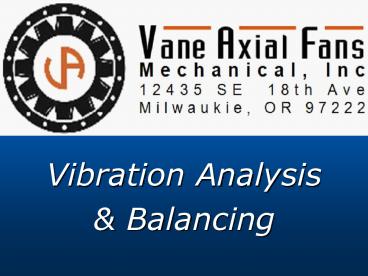Vibration Analysis - PowerPoint PPT Presentation
1 / 22
Title:
Vibration Analysis
Description:
Vibration Analysis & Balancing What is Vibration Analysis The study of Collected data taken with the analyzer, of a machine while it is running. – PowerPoint PPT presentation
Number of Views:271
Avg rating:3.0/5.0
Title: Vibration Analysis
1
- Vibration Analysis
- Balancing
2
What is Vibration Analysis
- The study of Collected data taken with the
analyzer, of a machine while it is running. - Data is collected at each location or point in
the horizontal, vertical and the axial plans. - Numerous bearing, motor and condition fault
frequencies are checked and compared.
3
Vibration Analysis
- What is vibration?
- Forces that vary in amplitude or direction over
time cause repetitive motions called vibration - When is vibration bad?
- All rotating machinery generates some vibration
- Only vibration that exceeds certain amplitude
levels is bad.
4
Vibration Terminology
- Amplitude
- The measure of energy or movement in a vibrating
object - Three common ways of expressing
- Displacement in mils peak to peak
- Velocity in inches/second peak
- Acceleration in gs rms
5
Vibration Terminology
- Frequency
- The number of times that a vibrating object
repeats its motion per unit of time - The rotational frequency is often called 1X
- Other frequencies are often identified as
multiples of 1X, such as 2X, 3X, 4X, etc.
6
Vibration Measurement
- We analyze vibration profiles from, motors, fans
and pumps, chillers, bearings and overall machine
health. - Were looking for bearing condition, mechanical
looseness, motor electrical problems, resonance
issues
7
Overall vs. Running speed-1X
- Overall amplitude is a measure of the vibration
energy over a wide frequency range - 1 times amplitude usually refers to the vibration
at operating/running speed - Overall amplitude includes the effects of all
sourceseven those external to the fan
8
Vibration Terminology
- Vibration Spectrum
- (a display of frequency vs. amplitude)
9
(No Transcript)
10
Profile Plot
11
Dynamic Unbalance
- Dynamic (couple) unbalance requires correction in
two or more planes
- Heavy spot will not bottom out when rotor is
placed in bearings
12
Achieving Lower Vibration Levels
- Involves better precision of many components
- Better balance of all rotating components
- Fan wheel (balance with fan shaft)
- Sheaves
- Couplings
- Motors
- Straighter shafts with precision diameter
tolerance and roundness - Less hop and wobble in fan wheel
- Better fits in attached components
13
Achieving Lower Vibration Levels
- Involves better precision of many components
(continued) - Reduced internal clearance in bearings
- Bearing mounting surfaces machined flat
- Premium quality v-belt drives
- Precision alignment of v-belt drives or couplings
- Precise tensioning of belts
14
Achieving Lower Vibration Levels
- Involves other special design considerations
- Heavier and more rigid components Use Class III
instead of Class II - Aluminum fan wheel (reduced rotor weight)
- Use inertia base for flexibly mounted fan
- Select lower speed fans if possible
- Avoid operation at any critical resonance speeds-
vibration can increase up to 10X amplitude
15
Balance
- Balancing
- The process of adding or removing weight on a
rotor in order to move the center of gravity
towards the axis of rotation - The purpose of balancing is to reduce the
unbalance forces that damage machines, there
surroundings and reduce noise transmitted to
tenants
16
(No Transcript)
17
Balance Tolerances
- Defines the maximum amount of residual unbalance
remaining after balancing - Originally defined in international standard ISO
1940/1 - Many new standards exist today.
- We use the manufactures specifications along with
years of experience to achieve best balance
possible
18
Balance and Vibration tolerances
- Proper balance
- Provides for long life,
- Higher efficiency and
- Reliable operation without excessive cost
19
(No Transcript)
20
Static Unbalance
- Static unbalance can be corrected by adding a
single weight
- Heavy spot will bottom out when the rotor is
placed in bearings
21
Dynamic Unbalance
- Dynamic (couple) unbalance requires correction in
two or more planes
- Heavy spot will not bottom out when rotor is
placed in bearings
22
503 657-4467
END































